- Home
- Carl Sagan
Comet Page 30
Comet Read online
Page 30
But it is a notion of mythic power. If an anthropologist of a previous generation had heard this story from his informants, the resulting scholarly tome would doubtless use words like “primitive” or “prescientific” or “animistic.” Consider:
The Sun has a Dark Sister. Long ago, before even great grandmother’s time, the two suns danced together in the sky. But the Dark One was jealous that her sister was so much brighter, and in her rage she cursed us for not loving her, and loosed comets upon the world. A terrible winter came, and darkness fell and bitter cold, and almost every living thing perished. After many seasons, the Bright Sister returned to her children, and it was warm and light once more, and life was renewed. But the Dark Sister is not dead. She is only hiding. One day she will return.
This is why some scientists thought the theory of the death star a joke when they first heard of it. An invisible sun attacking the Earth with comets sounds like delusion or, at best, myth. But the theory is serious and respectable, if highly speculative, science, because the principal idea is testable: You find the star and examine its orbital properties. It is no wonder, though, that one of the groups of scientists that first proposed the theory reached to mythology to name the star, and agreed to call it Nemesis, after the Greek goddess who visited just punishment on the self-righteous. They then went on to add, “We worry that if the companion is not found, this paper will be our Nemesis.”
A more disastrous situation than a comet shower would arise if Nemesis were perturbed into an orbit that takes it into the planetary system. In this case, it may strip some planets directly from the Solar System. It would leave the remaining planets in highly eccentric orbits which would produce a fast-moving, dangerous situation … A Nemesis with a semi-major axis of 90,000 A.U. is dangerous to life on Earth, but a Nemesis at the inner edge of the Oort Cloud would probably have produced a catastrophe of truly cosmogonical proportions.
—J. G. HILLS, “DYNAMICAL CONSTRAINTS ON THE MASS
AND PERIHELION DISTANCE OF NEMESIS AND THE
STABILITY OF ITS ORBIT,” NATURE, VOLUME 311, P. 636, 1984
If there is no Nemesis, some form of the galactic oscillation theory will become more probable, and we will have learned much about dim nearby stars, and perhaps something about the “missing mass” as well. Or it will strengthen the case of those who doubt there are periodic extinctions. There is no way that science loses. For the grandeur of its vision, and the new findings that will emerge even if there is no companion star, this theory is in the mainstream of science, a fact that is sometimes poorly appreciated in the press. The New York Times, on April 2, 1985, decided to take an editorial stand in this scientific debate, decrying the fact that discussion of extinctions
was suddenly snatched away by two brash Berkeley scientists and a crowd of astronomers … Terrestrial events, like volcanic activity or changes in climate or sea level, are the most immediate possible causes of mass extinctions. Astronomers should leave to astrologers the task of seeking the cause of earthly events in the stars.
In a letter dated April 14, 1985, Richard Muller and Walter Alvarez of the University of California’s Berkeley campus replied to the Times, concluding:
You say, “Complex events seldom have simple explanations.” The entire history of physics contradicts you.
You suggest “Astronomers should leave to astrologers the task of seeking the cause of earthly events in the stars.” May we suggest it might be best if editors left to scientists the task of adjudicating scientific questions?
The debate is likely to continue.
As for the name for the death star, should it be found, the American paleontologist, Stephen Jay Gould, argues that Nemesis is not quite right:
Nemesis is the personification of righteous anger. She attacks the vain or the powerful, and she works for definite cause … She represents everything that our new view of mass extinction is struggling to replace—predictable, deterministic causes afflicting those who deserve it …
Mass extinctions are not unswervingly destructive in the history of life. They are a source of creation as well … Mass extinction may be the primary and indispensable seed of major changes and shifts in life’s history … Moreover, mass extinction is probably blind to the exquisite adaptations evolved for previous environments of normal times. It strikes at random or by rules that transcend the plans and purposes of any victim.
Gould proposes instead that the companion star be named after the Hindu deity Siva, the Destroyer, for whom destruction is prerequisite to creation, and vice versa:
Siva does not attack specific targets for cause or for punishment. Instead, his placid face records the absolute tranquility and serenity of a neutral process, directed toward no one, but responsible for the maintenance and order of our world.
How characteristic of us, Gould is saying, that associating comets with “the wrath of heaven”—which Laplace denounced as superstition—should find its way into the most recent scientific views on the connection between comets and life on Earth.
*J. G. Hills, “Comet Showers and the Steady State Infall of Comets from the Oort Cloud,” Astronomical Journal, Volume 86, p. 1730, 1981.
*Although it is fair to note that almost half the mass in the Milky Way is “missing”—its gravitational influence is felt, but it corresponds to no known objects, neither stars nor gas nor dust.
*One of our scientific reviewers notes at this place in the margin, “If pigs had wings …” Indeed, not only has the companion star not been found, but there is no other evidence that requires its existence, beyond the debatable periodicities themselves.
CHAPTER 17
The Enchanted Region
We have now advanced to the extreme boundary of the solid ground of our knowledge of comets. Before us lies the enchanted region of speculation.
—WILLIAM HUGGINS, ON COMETS, FRIDAY-EVENING DISCOURSE,
THE ROYAL INSTITUTION, LONDON, JANUARY 20, 1882
Everything you see around you, alive or inanimate, has fallen from the sky—or, at least, the constituent atoms have. There was a time before the Earth was formed, when these atoms were parts of small worlds busily manufacturing planets as they collided. And there was a time before that, when all the atoms in and around you, every one of them, were in gas and microscopic grains floating in interstellar space. After the Earth was fully formed, more cosmic matter, chiefly from comets, glued itself to the Earth’s surface. Everything on Earth is sky stuff—collected, for a while at least, on this lump of metal, rock, and water.
In the scientific literature, as in myth and folklore, the implications of comets for life tend to be on the dire side. Only occasionally is there a suggestion that comets may be benign. The earliest such scientific statement seems to have been made by Isaac Newton in the Principia. He argues that cometary matter accumulates on Earth:
The vapors which arise from … the tails of the comets may meet at last with, and fall into, the atmospheres of the planets by their gravity, and there be condensed and turned into water and humid spirits; and from thence, by a slow heat, pass gradually into the forms of salts, and sulphurs, and tinctures, and mud, and clay, and sand, and stones, and coral, and other terrestrial substances.
There is a clear suggestion here that comets are made chiefly of water, although no justification of this assertion is offered. Newton goes on to argue that whatever cometary “vapors” arrive on Earth just balance those that are being lost, presumably to space, and that this contribution is essential for the continuing fecundity of the Earth. He concludes surprisingly, in an almost mystic reverie:
I suspect, moreover, that it is chiefly from the comets that spirit comes, which is indeed the smallest but the most subtle and useful part of our air, and so much required to sustain the life of all things with us.
Comets supply, Newton seems to be saying, something essential for life on Earth. But calling it “spirit” suggests it is not composed of matter. Demonstrating its presence in comets would then seem a
considerable undertaking, and Newton does not attempt it.
Other hopeful views of the biological role of comets were still more dubious. E.-J.-F. Sales-Guyon de Montlivault proposed in 1821 that originally people came to Earth by falling from the sky. A comet was implicated. Montlivault noticed the absence of human remains in most rock strata rich in the fossils of animals. Writing almost forty years before The Origin of Species, it seemed plausible to him that humans had originally grown up on the Moon, that the gravitational pull of a passing comet had splashed some lunar ocean onto the Earth, and that in that ocean were our ancestors. Perhaps they sailed reed boats and spoke ancient Egyptian. Evolution freed us from the necessity of such extravagant hypotheses.
If the comets were to contain something special for life—something that starts it, say, or something that stops it—there would be ample opportunity for that something to take effect. All over the Earth, all the time, there is a fine rain of cometary debris, particles ultimately derived from the interstellar medium. They fall into the atmosphere, are carried out by rain and snow, and become incorporated into plants and animals. We are surrounded by cosmic particles in our everyday life. We eat them and breathe them. And we are made of them. Some of these extraterrestrial atoms are incorporated into sperm and egg cells and carried down to future human generations.
In addition to the fluffy, organic-rich particles found in the stratosphere (Chapter 13), there are other, slightly larger, tokens of the comets. For example, if you dredge the ocean bottoms and then, after sieving and magnetic separation, examine all fine particles smaller than a grain of sand, you will find tiny, metal-rich glassy spheres. They are present on land also, but because the land is now so polluted by fine particles of human manufacture, the spherules are harder to find there. Since their appearance is so similar all over the Earth, you might think they were the product of some widely distributed small animal—eggs, perhaps, or droppings. But they are made uniformly of a kind of glass and metal, and are certainly not biological. Their nickel/iron ratio shows them to be extraterrestrial in origin.
These spherules are the remnants of small, originally irregular objects that entered the Earth’s atmosphere at high speed, were melted by friction with the air, and slowly fell through the atmosphere. They are called meteor ablation spheres—droplets that cooled and reso-lidified, teardrops falling on the Earth, a little like, but much more numerous than, the microtektites (Chapter 16). If you examine them, you find those chemical elements that are easily volatilized to be underrepresented. Carbon in organic matter is such an element, and sulfur. They have evidently been boiled off during entry. But other, more refractory elements are present in the usual cosmic proportions. The ablation spheres look like small pieces of cometary dust that melted, but otherwise survived high-speed entry into the Earth’s atmosphere. When interplanetary particles collected at stratospheric altitudes are melted experimentally in the laboratory, they take on the physical and chemical properties of the little spheres found on the ocean bottoms, and more rarely, in the stratosphere itself. And about 10 percent of the spheres collected from oceanic sediments contain grains of the parent material that have by accident escaped melting. To clinch the argument, the spherules contain radioactive isotopes such as manganese 53 that plausibly could be produced only by cosmic rays in space. Between the droplets and the flakes, we are awash in comet stuff.*
Through the effects of wind and water, temperature and the activities of microorganisms, all this cosmic debris becomes eroded, abraded, broken down, systematically converted into finer and finer grains, and ultimately reduced to individual molecules and atoms. The ponderous, multi-million-year circulation of the Earth’s crust and upper mantle carries the remains of cosmic particles deep below our feet; hundreds of kilometers down, material that once resided in the comets is part of some great convection cell which, tens of millions of years into the future, will surface and create some new continent or mountain range. The comets may seem remote to the point of myth or fable; but, in fact, they have a most lucid reality—they are a part of our planet and ourselves.
Of all the materials imagined to fall from comets, the most enduring—both in folklore and in science—have been, oddly, germs, the causative agents of disease. The worldwide association of comets with pestilence is striking, transcending cultural differences, and it is tempting to consider whether comets might in fact and not just in fancy be the carriers of epidemics. We recall, of course, that through most of human history, disease has been rife, so that purely by chance the apparition of a comet must on occasion coincide with the outbreak of pestilence somewhere. For example, the belief that the Great Plague of London, and the Great Fire, were caused by comets was sufficiently widespread to be discussed by Daniel Defoe in his Journal of the Plague Year. In 1829 a book by T. Forster was published called Atmospherical Causes of Epidemic Diseases, which argued for the same connection.
The idea is remarkably hardy, and has found a curious modern reincarnation. Fred Hoyle is a leading British astrophysicist who has made important contributions to cosmology, and to our understanding of the synthesis of chemical elements in the stars. He has also written popular science fiction, and the libretto of an opera. Hoyle and the Sri Lankan astrophysicist N. C. Wickramasinghe have examined the timing and geographical distribution of some cases of epidemic disease, and conclude that the pattern is not that expected if the disease propagates by contagion on the Earth’s surface, but rather is consistent with the pathogens falling from the sky. Most epidemiologists vigorously disagree.
The Comets of Plague and Fire
The comet before the Pestilence was of a faint, dull, languid colour, and its motion was very heavy, solemn, and slow; but … the comet before the Fire was bright and sparkling, or, as others said, flaming, and its motion swift and furious: and that accordingly one foretold a heavy judgment, slow but severe, terrible and frightful, as was the Plague; but the other foretold a stroke, sudden, swift, and fiery, as was the Conflagration. Nay, so particular some people were, that, as they looked upon the comet preceding the Fire, they fancied that they not only saw it pass swiftly and fiercely, and could perceive the motion with their eye, but even that they heard it; that it made a mighty rushing noise, fierce and terrible, though at a distance and but just perceivable. I saw both these stars, and must confess had I had so much the common notion of such things in my head … I could not but say, God had not yet sufficiently scourged the city.
—DANIEL DEFOE, A JOURNAL OF THE PLAGUE YEAR, LONDON, 1722
Moreover, Hoyle and Wickramasinghe hold that bacteria and viruses are sprinkled throughout interstellar space; indeed, they boldly propose that interstellar grains—which have about the same size and atomic composition as bacteria—are in fact bacteria. If true, bacteria would have been incorporated into comets as they condensed out of the solar nebula, which would itself have been made partly of microorganisms.
Steps leading to the origin of life on the primitive Earth, according to classic laboratory experiments. Some of the gases presumed to exist in the primitive atmosphere of the Earth are shown at top left. The hydrogen atoms are the small circles. Molecules shown at upper left are water vapor (H2O), methane (CH4), and ammonia (NH3). These molecules are broken into pieces (top right) by ultraviolet light from the Sun or electrical discharges. The fragments recombine to form, among other molecules, hydrogen cyanide (HCN) and formaldehyde (HCHO). The recombination in turn of these molecules in the ammoniated waters of the primitive Earth produces the simplest amino acids (lower right), the building blocks of protein. Similar steps lead to the building blocks of the nucleic acids. Molecules much more complex than those shown in this diagram have been generated in experiments simulating the origin of life on the early Earth. Painting by Jon Lomberg.
While the sweep of this proposal is very grand, its supporting evidence is sparse. The elaborate molecular machinery employed by both sides in the continuing warfare between infection and immunity speaks of a long evolutionary r
elationship between humans and disease microorganisms; this would be hard to arrange if the microbes had recently fallen from a comet that had last seen the inner solar system four and a half billion years ago. Generating all those interstellar microbes seems very difficult; further, hardly all properties of interstellar grains are shared by microbes, and vice versa. There is no report of major epidemics associated—even with a one-year time delay to allow for the bugs drifting down from the stratosphere—with spectacular meteor showers. Moreover, the cometary debris collected by stratospheric aircraft (Chapter 13) is not reported to contain the charred and mangled bodies of, say, the diphtheria, polio, or cholera pathogens. Scientists examining recovered cometary particles do not seem to be dying of mysterious illnesses. Such facts must be considered among the deficiencies of the hypothesis.
In addition, Hoyle and Wickramasinghe explicitly propose that life has arisen inside the comet (rather than surviving from pre-cometary eons), and is falling on the Earth to generate disease. Here again, the apparent absence of pathogens in recovered cometary grains poses a serious problem. But the idea that conditions inside a comet might be conducive to the origin of life is worth further consideration.

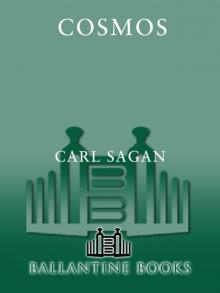 Cosmos
Cosmos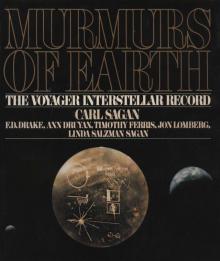 Murmurs of Earth
Murmurs of Earth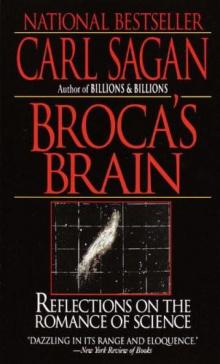 Broca's Brain
Broca's Brain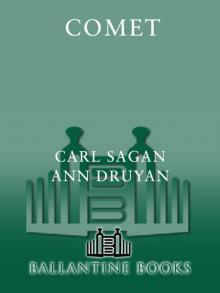 Comet
Comet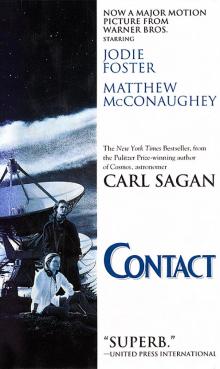 Contact
Contact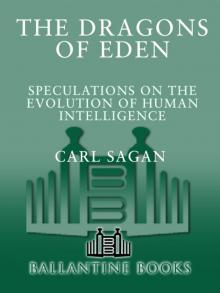 Dragons of Eden
Dragons of Eden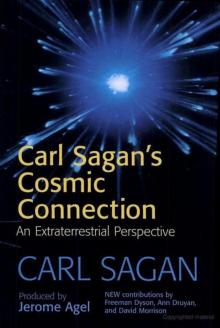 Cosmic Connection
Cosmic Connection Shadows of Forgotten Ancestors
Shadows of Forgotten Ancestors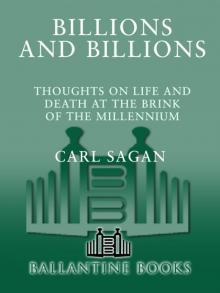 Billions & Billions
Billions & Billions Comet, Revised
Comet, Revised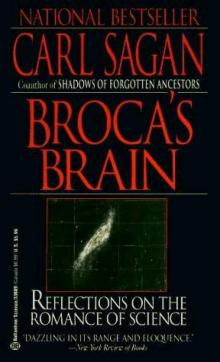 Broca's Brain: The Romance of Science
Broca's Brain: The Romance of Science The Varieties of Scientific Experience: A Personal View of the Search for God
The Varieties of Scientific Experience: A Personal View of the Search for God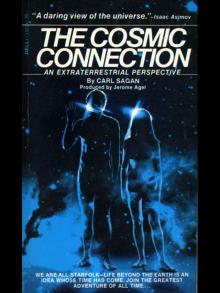 The Cosmic Connection
The Cosmic Connection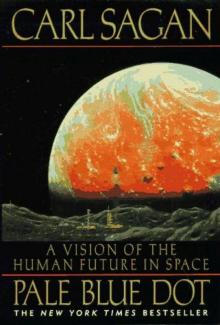 Pale Blue Dot: A Vision of the Human Future in Space
Pale Blue Dot: A Vision of the Human Future in Space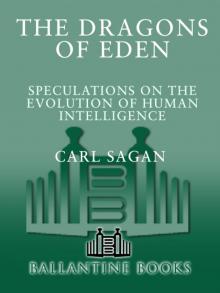 The Dragons of Eden
The Dragons of Eden